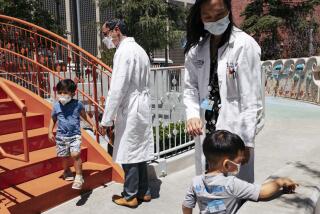The Risks of Poor Parenting : Health: Government programs aren’t enough; parents, community must do their part.
- Share via
The advances that brought dramatic improvements in child health in the past cannot cure what ails our children today. Car crashes have replaced smallpox as the leading child health menace. Homicide, suicide, child abuse and neglect are the bellwether childhood diseases of the 1990s.
The Bush Administration recently launched a number of child-health initiatives, including campaigns to reduce infant mortality, the number of unvaccinated preschoolers and the incidence of lead poisoning. We have expanded Medicaid coverage of poor and near-poor children and funded the largest expansion of Head Start in its 26-year history.
However, our children need more than government programs. They need to be loved, guided and protected by parents, family, neighbors, religious and other community leaders. There are no vaccines against child abuse. Seat belts can’t protect innocent children from stray bullets.
We are raising a generation of “shell-shocked” children, traumatized by the violence in their homes and neighborhoods. A recent study found that one in three children in an urban neighborhood had witnessed a shooting or stabbing. This ecology of violence takes its toll. These children displayed three times more depression, fear and hyperactivity than the national average.
The single greatest risk factor for poor child health is poor parenting. In my conversations with health-care professionals, from school nurses to emergency-room physicians, a common thread has emerged, a deep concern that children are not being nurtured by their parents. For reasons ranging from immaturity to exhaustion to pursuit of self-gratification, parents today spend 40% less time with their children than parents did in 1965. Our children average 17 hours a week with mom and dad, and more than 25 hours with a TV nanny.
More than half of today’s children will spend their childhood in a single-parent family. When one parent must do the job of two, children have an increased risk of health problems. Children who have experienced disruption of their parents’ marriage are more likely to have an accident, injury or poisoning.
Most injuries aren’t caused by random fate, but are predictable and preventable. Injuries are now the leading killer of children, causing more deaths than all diseases combined. In 1988, unintentional injuries (car accidents, drowning, mishaps) and intentional injuries (homicide, suicide, child abuse) took the lives of 22,426 children, leaving an additional 30,000 with permanent disabilities.
The steps we can take to protect our children sound so simple and obvious that we may be tempted to ignore them. We can install smoke detectors and sprinkler systems in our homes; require helmets when bicycling, and child-proof our homes by erecting fences around swimming pools.
These preventive measures are as essential to good health as antibiotics for curing an ear infection. Car crashes account for the largest loss of potential years of life, yet many parents remain lax about the use of seat belts and child safety seats. These restraints could prevent about 56,000 injuries a year.
By modifying our environment and behavior, we can go a long way toward providing a safe and healthy childhood for our children.





